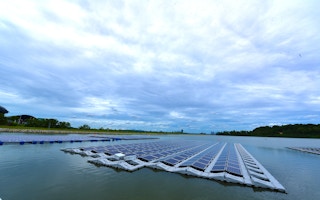The year 2016 saw renewable energy gain greater momentum, with solar shining brighter than ever. Earlier in the year, a United Nations Environment Programme (UNEP) report showed investments in green power have jumped far ahead of investments in fossil fuels with solar increasingly becoming a cheaper alternative.
To continue reading, subscribe to Eco‑Business.
There's something for everyone. We offer a range of subscription plans.
- Access our stories and receive our Insights Weekly newsletter with the free EB Member plan.
- Unlock unlimited access to our content and archive with EB Circle.
- Publish your content with EB Premium.
Elon Musk made global headlines with the launch of Tesla’s solar roof tiles. While in the UK, British prime minister Theresa May approved the Hinkley Point C nuclear power plant - the country’s first new nuclear power plant in two decades - to the great dismay of critics who called the project “flawed and expensive”.
The election of Donald Trump, a known climate denier, as president of the United States was the big surprise of the year. His election had an immediate effect on oil and gas stocks as he has vowed to revive the US coal, oil and gas industry.
Here are the top five energy stories in 2016:
1. The Trump effect on energy
On November 8, Donald John Trump was elected 45th president of the United States of America. His surprise election happened while world leaders were gathered in Marrakesh, Morocco to discuss the implementation of the historic Paris Agreement on climate change.
Trump has vowed to pull the US out of the Paris Agreement and to “fire up” the US coal, oil and gas industries, to the dismay of environmentalists and governments around the world who fear that he will stifle any progress made on climate action over recent years. The president-elect has also picked climate sceptics and oil industry executives for key positions in his administration.
Industry observers however have sought to assuage fears about his impact, pointing to a global momentum in renewable energy investment and the commitment of all other UN members to the Paris Agreement as reasons to stay optimistic that the world will continue to decarbonise the global economy.
2. Global investment in renewable energy reaches new highs
Latest figures by Bloomberg New Energy Finance, published in a report called Global Trends in Renewable Energy Investment 2016, showed that investments in renewable energy rose 5 per cent to $285.9 billion in 2015, exceeding the previous record of $278.5 billion achieved in 2011.
Total capacity installed from renewable energy sources, particularly wind and solar, came to 118GW, far above the next highest annual figure, 2014’s 94GW.
Overall, renewables excluding large hydro made up 53.6 per cent of the gigawatt capacity of all technologies installed in 2015, the first time it has represented a majority, suggesting that structural changes are underway to usher in a transition to clean energy.
The green energy transition is expected to sustain its momentum. This year, renewable energy leader Germany has announced it will overhaul its flagship renewable energy policy called Energiewende from feed-in-tariffs to auctions that will ensure more competition, continuous growth, and cost restrictions.
3. Tesla’s clean energy revolution
From electric cars to long-lasting storage batteries to solar roof tiles, Tesla’s Elon Musk is moving towards realising his dream of selling a fossil fuel-free lifestyle to consumers.
The company unveiled its first “mass market” EV, a game-changing move that drove EV prices down and continues to threaten the future of petrol cars. The Tesla Model 3 was offered at US$35,000, can run for 215 miles (346 kilometres) per charge and has a pick-up speed reaching 60 mph (96.5 kph) in under six seconds.
Elon Musk’s clean energy vision also expanded to include a cheaper version of its solar battery storage. Dubbed Powerwall 2, the technology offers bigger storage capacity that can power a two-bedroom home for a full day. The technology entrepreneur also unveiled Tesla’s solar roof tiles, which are set to revolutionise the way solar is integrated into homes.
“This is the integrated future. An electric car, a Powerwall and a solar roof. The key is it needs to be beautiful, affordable and seamlessly integrated,” Musk said at the launch.
4. The Hinkley Point C deal
Newly minted British prime minister Theresa May finally approved the Hinkley Point C nuclear deal - the UK’s first nuclear project in two decades, prompting a barrage of criticism.
The Telegraph said Hinkley C will be “obsolete before it even starts… [it] will be overtaken by a host of cheaper technologies before it is even opened in the late 2020s, and risks degenerating into an epic white elephant”.
Meanwhile, the Guardian argued that Hinkley C is “an unproven design that comes with a punitive cost… nuclear, with its lethal waste and high decommissioning costs, is no long-term solution.”
5. Solar gets smarter in sunny Singapore
Meanwhile in Singapore, the sunny city-state launched this year the world’s largest floating solar photovoltaic test bed, which involves solar panels lying afloat one hectare of water in the country’s Tengeh Reservoir.
Spearheaded by the Economic Development Board and national water agency PUB, and managed by the Solar Energy Research Institute of Singapore (SERIS), the test bed currently has a capacity of one megawatt peak of solar energy.
Solar PV technology also grew smarter this year, with European developers bringing smart solar panels that automatically change angles to face the direction from which it can harvest the most energy from the sun.
Google Earth also launched a new technology that identifies areas where solar panel installation will produce the most energy and where it won’t, guiding people’s decisions prior to purchasing and installing solar panels.
This story is part of our Year in Review series, which looks at the top stories that shaped the business and sustainability scene in each of our 12 categories.














